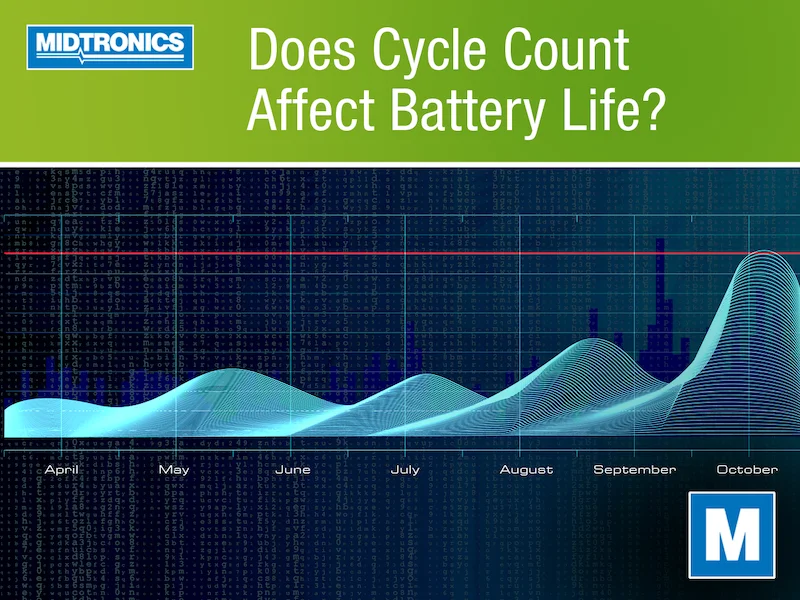Vehicle owners want to get the most out of car batteries, and considering how important they are for everything from powering our vehicles to running other automotive systems, it can be difficult to tell whether a battery is close to its point of failure. Understanding cycle count and how it relates to the type of battery can be vital in determining battery life, and it’s practical knowledge that every technician and shop owner should have.
What’s the relationship between cycle count and battery life, and is it really a major determiner of condition? Here, we look at an array of different types of flooded lead-acid, Enhanced Flooded Batteries (EFB), Absorbed Glass Mat Batteries (AGM), and lithium-ion (Li-ion) batteries, and why cycle count matters so much when it comes to extending a car battery’s lifespan.
The Importance of Cycle Count in Determining Battery Life
Battery life is a crucial component of any modern device, and that’s especially true for cars. As our reliance on technology continues to grow, so too does our need for longer-lasting batteries. It’s no secret that battery life can make or break a device, which makes understanding the cycle count all the more important.
Quite simply, cycle count is the number of times a battery can be depleted and recharged before its full capacity begins to degrade. This number varies depending on the type of battery and how it’s used, meaning that any accurate assessment of battery life must take cycle count into account.
What’s considered one discharge cycle? It’s when a charged battery is fully depleted, then recharged to its full capacity once again. But a car battery rarely encounters this type of cycle, since the result would be a dead battery that needs to be put on a charger. Instead, it’s always a partial discharge cycle that occurs. So, four discharges of 25% equal one full discharge cycle.
Whether you’re a tech novice or a seasoned pro, understanding the importance of cycle count is crucial for diagnosing and repairing various conditions that can plague customer cars, particularly when it’s time to replace a failing battery. But figuring out how many discharge cycles a battery has experienced is difficult in passenger cars, if not impossible.
How Cycle Count Works for Different Battery Types
Flooded lead-acid batteries, EFB, AGM, and Li-ion batteries all have different characteristics and therefore require different approaches when it comes to cycling. Essentially, cycle count refers to the number of times a battery can be charged and discharged before its performance begins to decline.
Proper cycle count management is crucial in maximizing the lifespan and efficiency of your batteries. By understanding the nuances of cycle count for each type of battery, you can ensure that your batteries are performing at their best and avoid costly replacements.
- For lead-acid car batteries, you can typically expect around 500 discharge cycles before beginning to experience a noticeable drop. After 500 cycles, it’s common to have 30% less capacity.
- For EFB and AGM batteries, the benchmark is around 1,200 discharge cycles before you experience the same 30% drop in capacity.
- For Li-Ion batteries that have been properly maintained, no noticeable drop in capacity is experienced until after 1,200 discharge cycles.
But since there isn’t a cycle counter installed in a vehicle, how can you tell when a battery is deteriorating due to a high cycle count? The simple answer is, you can’t. That figure is intended to help with the selection of a new battery, pairing the correct technology with the customer’s vehicle. However, you can use the customer’s usage as an approximate gauge of the battery’s health, supported by the data from a battery test.
Best Practices to Maximize Battery Life and Extend Cycle Life
What, then, does that mean for how you service your customers’ vehicles? Because you can’t accurately calculate the number of discharge cycles from a car’s battery doesn’t mean it should be ignored. For example, if you see a car with a two-year-old battery but it’s been installed for 80,000 miles – like for an Uber driver – it might’ve far surpassed 500 discharge cycles in that time. Conversely, a newer car with an EFB battery with low mileage might go well past five years with no noticeable deterioration in capacity.
You can still help your customers avoid annoying and expensive breakdowns by promoting battery health and suggesting the right batteries for their operating conditions. As well, these five recommendations can help:
- Stay on top of regular maintenance. Perform routine battery maintenance for customer cars including visual inspections, checking the terminals for corrosion, and cleaning them if necessary. Also, ensure that batteries are securely fastened in the tray to minimize vibration damage.
- Avoid deep discharges. Try to avoid deep discharges of your car battery, as this can significantly reduce its lifespan. Suggest that, if possible, car owners use electronics and accessories while the engine is running to minimize the strain on the battery.
- Advise drivers to avoid short trips. Short trips prevent a car’s battery from fully recharging, leading to a gradual decline in its capacity. Whenever possible, advise owners to combine multiple errands into one trip to allow the alternator enough time to recharge the battery fully.
- Cool conditions are best. Extreme heat can negatively impact battery performance, even more than extreme cold. Recommend that drivers park their vehicles in shaded areas during hot summer days and consider using a battery warmer during winter to maintain optimal operating conditions.
- Get regular battery tests. A car battery’s voltage and conductance should be tested at regular intervals using a reliable battery tester. This will help you identify potential issues early on and take appropriate measures to rectify them.
And when there are electrical concerns present, always check the battery as a potential first point of failure.




